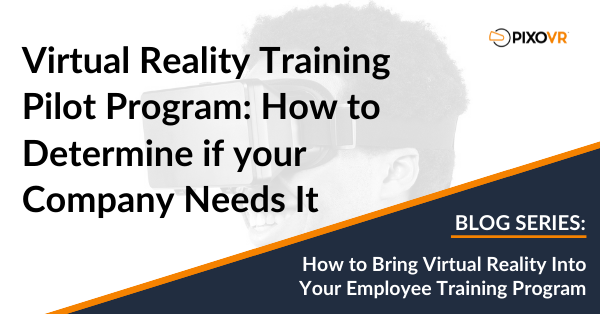The following is an excerpt from our whitepaper: ‘How to Bring Virtual Reality Into Your Employee Training Program’:
Running a pilot for bringing VR training into your program can be highly beneficial or it can distract from attaining your rollout goals. The key is to determine what you want the pilot to prove and have a way to measure it. The biggest mistake with pilots is to go in with the idea of trying it out, but have no way to measure success. Oftentimes what training leaders really need is a rollout plan with an initial test group so they can work out any issues before expanding to more trainees. Let’s consider the reasons to adopt VR training and when a pilot is needed versus an initial rollout.
Reason to Adopt VR Training: To reduce costs
Pilot or Start Rollout?: Pilot
Metrics: Does it work remotely?, Scores, User feedback
Pilot/Rollout Considerations: Cost reduction relative to shutting down important machinery or reducing employee travel are clear and there is no need to prove the cost difference. However, there is often a desire to prove that the training content is effective. For these scenarios, custom content is typically needed. If you want to prove that remote training works, then this is a pass/fail pilot based on user feedback and test scores. The key to success is to keep the pilot phase as short as possible and measure test scores to show that the VR training is as good as or better than current methods. Getting agreement on this upfront will allow for a faster rollout and faster time to cost savings.
Reason to Adopt VR Training: To fill a skilled labor gap
Pilot or Start Rollout?: Pilot
Metrics: Scores, User feedback, Time to train
Pilot/Rollout Considerations: Using VR training to fill a skilled labor gap could be piloted in various ways depending on what you are currently doing for training hard skills. If you aren’t yet doing anything, then the pilot can only be used to show efficacy. This can be done by taking a few standard training modules and showing that unskilled labor can be trained using VR. If you are doing training already, then you would want to compare the results to existing training. This might require creating custom content so that it is as close as possible for comparison. Then you would measure the scores, the time to train, and user satisfaction to compare.
Reason to Adopt VR Training: To improve safety
Pilot or Start Rollout?: Start rollout
Metrics: Scores, User feedback
Pilot/Rollout Considerations: Doing a pilot to prove that workplace injuries are reduced is not viable. This type of data would need to be gathered over a long period of time and defeats the idea of a pilot. Instead, an initial rollout can be done to determine if employees like the training and to ensure they score well, but a pilot may not be needed in this scenario. Particularly since there is a large library of standard safety training that has been proven effective for other companies.
Reason to Adopt VR Training: To engage a younger workforce
Pilot or Start Rollout?: Start rollout
Metrics: Scores, User feedback
Pilot/Rollout Considerations: This is another scenario where a pilot is optional and would only be done if management wanted proof of efficacy for the type of training that VR would be applied to. Younger generations are already familiar with VR from gaming applications so adoption is not a concern. Thinking of the retail/food service industries, the “pilot” may just be the first store/location that the training is rolled out to as part of the rollout plan.
Reason to Adopt VR Training: To enhance soft skills
Pilot or Start Rollout?: Start rollout
Metrics: Scores, User feedback
Pilot/Rollout Considerations: Using VR training for soft skills is just a more interactive way to deliver training content. If you are concerned with user adoption, you can make headsets available for users to try with gaming or trial applications, but there isn’t much here that can be measured and training is typically standard. A slow rollout where user satisfaction and scores are measured works well without a need for a pilot.
Reason to Adopt VR Training: To improve employee wellness
Pilot or Start Rollout?: Start rollout
Metrics: User feedback
Pilot/Rollout Considerations: The only question here is will employees use VR as a way to meditate or prepare for high performance activities. Meditation and mindfulness exercises done before skills training has been shown to improve training outcomes so a good test might be using it before existing training and comparing scores. As far as adoption, a slow rollout can be done where the first group uses the content and provides video testimonials on their experience. This will help encourage company-wide adoption.
Download the whitepaper: ‘How to Bring Virtual Reality Into Your Employee Training Program’


Leave a Reply
You must be logged in to post a comment.